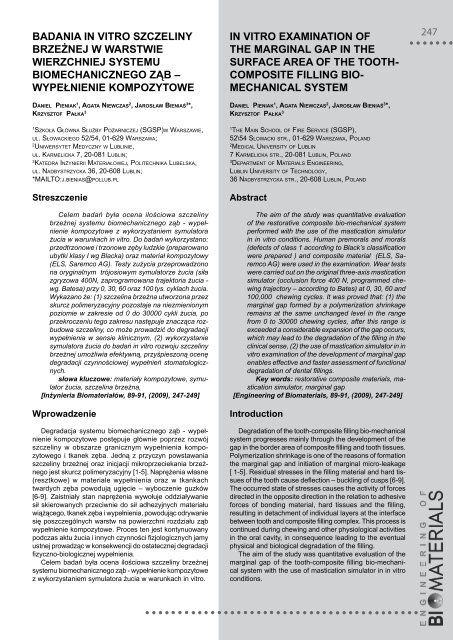89-91 - Polskie Stowarzyszenie Biomateriałów
89-91 - Polskie Stowarzyszenie Biomateriałów
89-91 - Polskie Stowarzyszenie Biomateriałów
You also want an ePaper? Increase the reach of your titles
YUMPU automatically turns print PDFs into web optimized ePapers that Google loves.
Badania in vitro szczeliny<br />
brzeżnej w warstwie<br />
wierzchniej systemu<br />
biomechanicznego ząb –<br />
wypełnienie kompozytowe<br />
Daniel Pieniak 1 , agata niewczas 2 , Jarosław Bieniaś 3 *,<br />
Krzysztof PałKa 3<br />
1Szkoła Główna Służby Pożarniczej (SGSP)w warSzawie,<br />
ul. SłowackieGo 52/54, 01-629 warSzawa;<br />
2uniwerSytet Medyczny w lublinie,<br />
ul. karMelicka 7, 20-081 lublin;<br />
3katedra inżynierii Materiałowej, Politechnika lubelSka,<br />
ul. nadbyStrzycka 36, 20-608 lublin;<br />
*Mailto:j.bieniaS@Pollub.Pl<br />
streszczenie<br />
Celem badań była ocena ilościowa szczeliny<br />
brzeżnej systemu biomechanicznego ząb - wypełnienie<br />
kompozytowe z wykorzystaniem symulatora<br />
żucia w warunkach in vitro. Do badań wykorzystano:<br />
przedtrzonowe i trzonowe zęby ludzkie (preparowano<br />
ubytki klasy I wg Blacka) oraz materiał kompozytowy<br />
(ELS, Saremco AG). Testy zużycia przeprowadzono<br />
na oryginalnym trójosiowym symulatorze żucia (siła<br />
zgryzowa 400N, zaprogramowana trajektoria żucia -<br />
wg. Batesa) przy 0, 30, 60 oraz 100 tys. cyklach żucia.<br />
Wykazano że: (1) szczelina brzeżna utworzona przez<br />
skurcz polimeryzacyjny pozostaje na niezmienionym<br />
poziomie w zakresie od 0 do 30000 cykli żucia, po<br />
przekroczeniu tego zakresu następuje znacząca rozbudowa<br />
szczeliny, co może prowadzić do degradacji<br />
wypełnienia w sensie klinicznym, (2) wykorzystanie<br />
symulatora żucia do badań in vitro rozwoju szczeliny<br />
brzeżnej umożliwia efektywną, przyśpieszoną ocenę<br />
degradacji czynnościowej wypełnień stomatologicznych.<br />
słowa kluczowe: materiały kompozytowe, symulator<br />
żucia, szczelina brzeżna,<br />
[Inżynieria <strong>Biomateriałów</strong>, <strong>89</strong>-<strong>91</strong>, (2009), 247-249]<br />
wprowadzenie<br />
Degradacja systemu biomechanicznego ząb - wypełnienie<br />
kompozytowe postępuje głównie poprzez rozwój<br />
szczeliny w obszarze granicznym wypełnienia kompozytowego<br />
i tkanek zęba. Jedną z przyczyn powstawania<br />
szczeliny brzeżnej oraz inicjacji mikroprzeciekania brzeżnego<br />
jest skurcz polimeryzacyjny [1-5]. Naprężenia własne<br />
(resztkowe) w materiale wypełnienia oraz w tkankach<br />
twardych zęba powodują ugięcie – wyboczenie guzków<br />
[6-9]. Zaistniały stan naprężenia wywołuje oddziaływanie<br />
sił skierowanych przeciwnie do sił adhezyjnych materiału<br />
wiążącego, tkanek zęba i wypełnienia, powodując odrywanie<br />
się poszczególnych warstw na powierzchni rozdziału ząb<br />
wypełnienie kompozytowe. Proces ten jest kontynuowany<br />
podczas aktu żucia i innych czynności fizjologicznych jamy<br />
ustnej prowadząc w konsekwencji do ostatecznej degradacji<br />
fizyczno-biologicznej wypełnienia.<br />
Celem badań była ocena ilościowa szczeliny brzeżnej<br />
systemu biomechanicznego ząb - wypełnienie kompozytowe<br />
z wykorzystaniem symulatora żucia w warunkach in vitro.<br />
in vitro examination of<br />
the marginal gap in the<br />
surface area of the toothcomposite<br />
filling biomechanical<br />
system<br />
Daniel Pieniak 1 , agata niewczas 2 , Jarosław Bieniaś 3 *,<br />
Krzysztof PałKa 3<br />
1 the Main School of fire Service (SGSP),<br />
52\54 Slowacki Str., 01-629 warSzawa, Poland<br />
2 Medical univerSity of lublin<br />
7 karMelicka Str., 20-081 lublin, Poland<br />
3 dePartMent of MaterialS enGineerinG,<br />
lublin univerSity of technoloGy,<br />
36 nadbyStrzycka Str., 20-608 lublin, Poland<br />
abstract<br />
The aim of the study was quantitative evaluation<br />
of the restorative composite bio-mechanical system<br />
performed with the use of the mastication simulator<br />
in in vitro conditions. Human premorals and morals<br />
(defects of class 1 according to Black’s classification<br />
were prepared ) and composite material (ELS, Saremco<br />
AG) were used in the examination. Wear tests<br />
were carried out on the original three-axis mastication<br />
simulator (occlusion force 400 N, programmed chewing<br />
trajectory – according to Bates) at 0, 30, 60 and<br />
100,000 chewing cycles. It was proved that: (1) the<br />
marginal gap formed by a polymerization shrinkage<br />
remains at the same unchanged level in the range<br />
from 0 to 30000 chewing cycles, after this range is<br />
exceeded a considerable expansion of the gap occurs,<br />
which may lead to the degradation of the filling in the<br />
clinical sense, (2) the use of mastication simulator in in<br />
vitro examination of the development of marginal gap<br />
enables effective and faster assessment of functional<br />
degradation of dental fillings.<br />
Key words: restorative composite materials, mastication<br />
simulator, marginal gap<br />
[Engineering of Biomaterials, <strong>89</strong>-<strong>91</strong>, (2009), 247-249]<br />
introduction<br />
Degradation of the tooth-composite filling bio-mechanical<br />
system progresses mainly through the development of the<br />
gap in the border area of composite filling and tooth tissues.<br />
Polymerization shrinkage is one of the reasons of formation<br />
the marginal gap and initiation of marginal micro-leakage<br />
[ 1-5]. Residual stresses in the filling material and hard tissues<br />
of the tooth cause deflection – buckling of cusps [6-9].<br />
The occurred state of stresses causes the activity of forces<br />
directed in the opposite direction in the relation to adhesive<br />
forces of bonding material, hard tissues and the filling,<br />
resulting in detachment of individual layers at the interface<br />
between tooth and composite filling complex. This process is<br />
continued during chewing and other physiological activities<br />
in the oral cavity, in consequence leading to the eventual<br />
physical and biological degradation of the filling.<br />
The aim of the study was quantitative evaluation of the<br />
marginal gap of the tooth-composite filling bio-mechanical<br />
system with the use of mastication simulator in in vitro<br />
conditions.<br />
247













